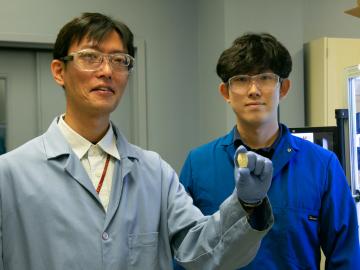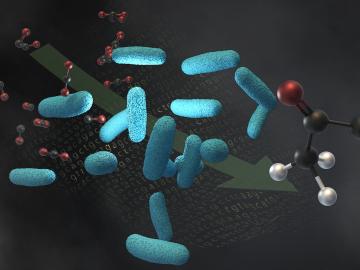
Filter News
Area of Research
- (-) Advanced Manufacturing (1)
- (-) Biology and Environment (28)
- (-) Materials (46)
- (-) Supercomputing (36)
- Biology and Soft Matter (1)
- Computer Science (5)
- Electricity and Smart Grid (3)
- Energy Science (75)
- Functional Materials for Energy (1)
- Fusion and Fission (9)
- Fusion Energy (7)
- Materials for Computing (6)
- National Security (9)
- Neutron Science (12)
- Nuclear Science and Technology (12)
- Nuclear Systems Modeling, Simulation and Validation (1)
- Quantum information Science (9)
- Sensors and Controls (1)
- Transportation Systems (1)
News Topics
- (-) Advanced Reactors (5)
- (-) Grid (11)
- (-) Microscopy (35)
- (-) Quantum Science (33)
- 3-D Printing/Advanced Manufacturing (46)
- Artificial Intelligence (43)
- Big Data (29)
- Bioenergy (54)
- Biology (76)
- Biomedical (32)
- Biotechnology (15)
- Buildings (8)
- Chemical Sciences (36)
- Clean Water (14)
- Composites (14)
- Computer Science (108)
- Coronavirus (23)
- Critical Materials (15)
- Cybersecurity (9)
- Energy Storage (38)
- Environment (114)
- Exascale Computing (28)
- Frontier (32)
- Fusion (9)
- High-Performance Computing (58)
- Hydropower (8)
- Irradiation (1)
- Isotopes (14)
- ITER (1)
- Machine Learning (21)
- Materials (88)
- Materials Science (90)
- Mathematics (5)
- Mercury (7)
- Molten Salt (3)
- Nanotechnology (44)
- National Security (9)
- Neutron Science (47)
- Nuclear Energy (20)
- Partnerships (13)
- Physics (35)
- Polymers (19)
- Quantum Computing (21)
- Security (7)
- Simulation (26)
- Software (1)
- Space Exploration (6)
- Summit (47)
- Transportation (20)
Media Contacts

Scientists at ORNL used neutron scattering to determine whether a specific material’s atomic structure could host a novel state of matter called a spiral spin liquid.

Chemical and environmental engineer Samarthya Bhagia is focused on achieving carbon neutrality and a circular economy by designing new plant-based materials for a range of applications from energy storage devices and sensors to environmentally friendly bioplastics.

Science has taken Melanie Mayes from Tennessee to the tropics, studying some of the most important ecosystems in the world.

ORNL researchers have developed an upcycling approach that adds value to discarded plastics for reuse in additive manufacturing, or 3D printing.

To optimize biomaterials for reliable, cost-effective paper production, building construction, and biofuel development, researchers often study the structure of plant cells using techniques such as freezing plant samples or placing them in a vacuum.

Jennifer Morrell-Falvey’s interest in visualizing the science behind natural processes was what drew her to ORNL in what she expected to be a short stint some 18 years ago.

Researchers at ORNL are teaching microscopes to drive discoveries with an intuitive algorithm, developed at the lab’s Center for Nanophase Materials Sciences, that could guide breakthroughs in new materials for energy technologies, sensing and computing.

Scientists’ increasing mastery of quantum mechanics is heralding a new age of innovation. Technologies that harness the power of nature’s most minute scale show enormous potential across the scientific spectrum

A team of scientists from LanzaTech, Northwestern University and ORNL have developed carbon capture technology that harnesses emissions from industrial processes to produce acetone and isopropanol

ORNL, TVA and TNECD were recognized by the Federal Laboratory Consortium for their impactful partnership that resulted in a record $2.3 billion investment by Ultium Cells, a General Motors and LG Energy Solution joint venture, to build a battery cell manufacturing plant in Spring Hill, Tennessee.


